Abstract
1. In 44 patients undergoing coronary artery bypass grafting, the effect of chronic administration of the beta-adrenoceptor antagonists sotalol, propranolol, pindolol, metoprolol and atenolol on beta-adrenoceptor density in right atria (containing 70% beta 1- and 30% beta 2-adrenoceptors) and in lymphocytes (having only beta 2-adrenoceptors) was studied. 2. beta-Adrenoceptor density in right atrial membranes and in intact lymphocytes was assessed by (-)-[125I]-iodocyanopindolol (ICYP) binding; the relative amount of right atrial beta 1- and beta 2-adrenoceptors was determined by inhibition of ICYP binding by the selective beta 2-adrenoceptor antagonist ICI 118,551 and analysis of the resulting competition curves by the iterative curve fitting programme LIGAND. 3. With the exception of pindolol, all beta-adrenoceptor antagonists increased right atrial beta-adrenoceptor density compared to that observed in atria from patients not treated with beta-adrenoceptor antagonists. 4. All beta-adrenoceptor antagonists increased right atrial beta 1-adrenoceptor density; on the other hand, only sotalol and propranolol also increased right atrial beta 2-adrenoceptor density, whereas metoprolol and atenolol did not affect it and pindolol decreased it. 5. Similarly, in corresponding lymphocytes, only sotalol or propranolol increased beta 2-adrenoceptor density, while metoprolol and atenolol did not affect it and pindolol decreased it. 6. It is concluded that beta-adrenoceptor antagonists subtype-selectively regulate cardiac and lymphocyte beta-adrenoceptor subtypes. The selective increase in cardiac beta 1-adrenoceptor density evoked by metoprolol and atenolol may be one of the reasons for the beneficial effects observed in patients with end-stage congestive cardiomyopathy following intermittent treatment with low doses of selective beta 1-adrenoceptor antagonists.
Full text
PDF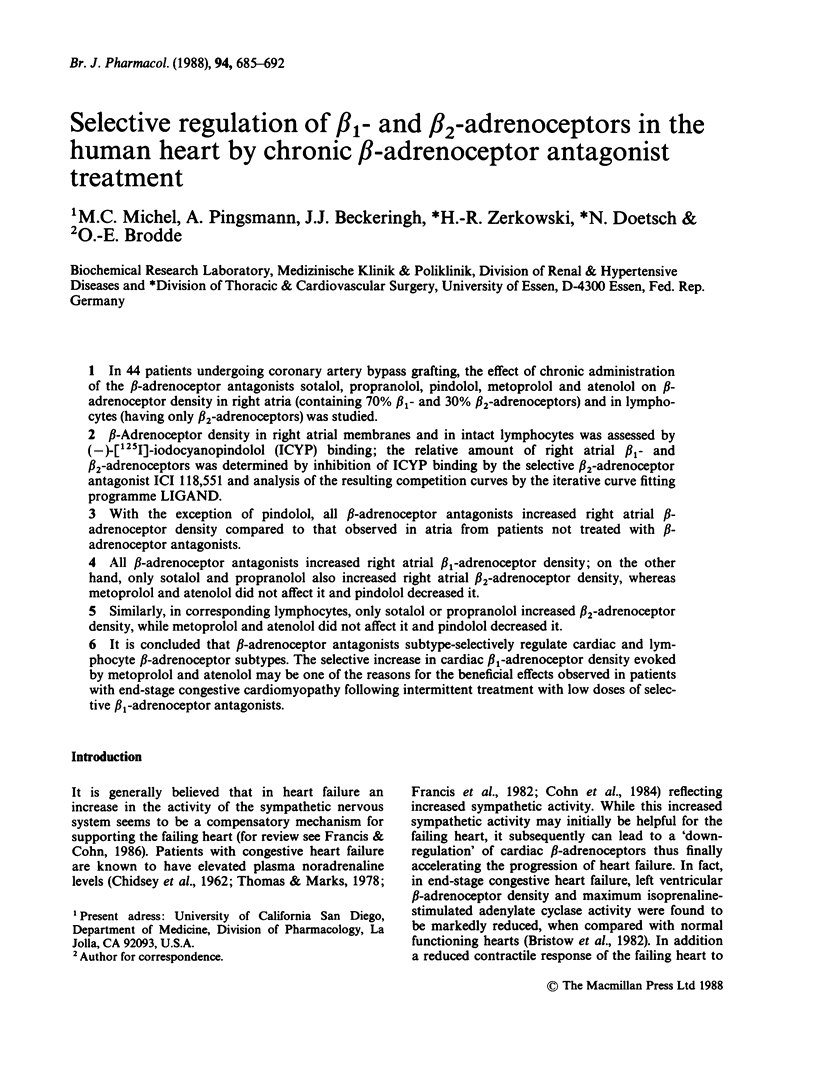
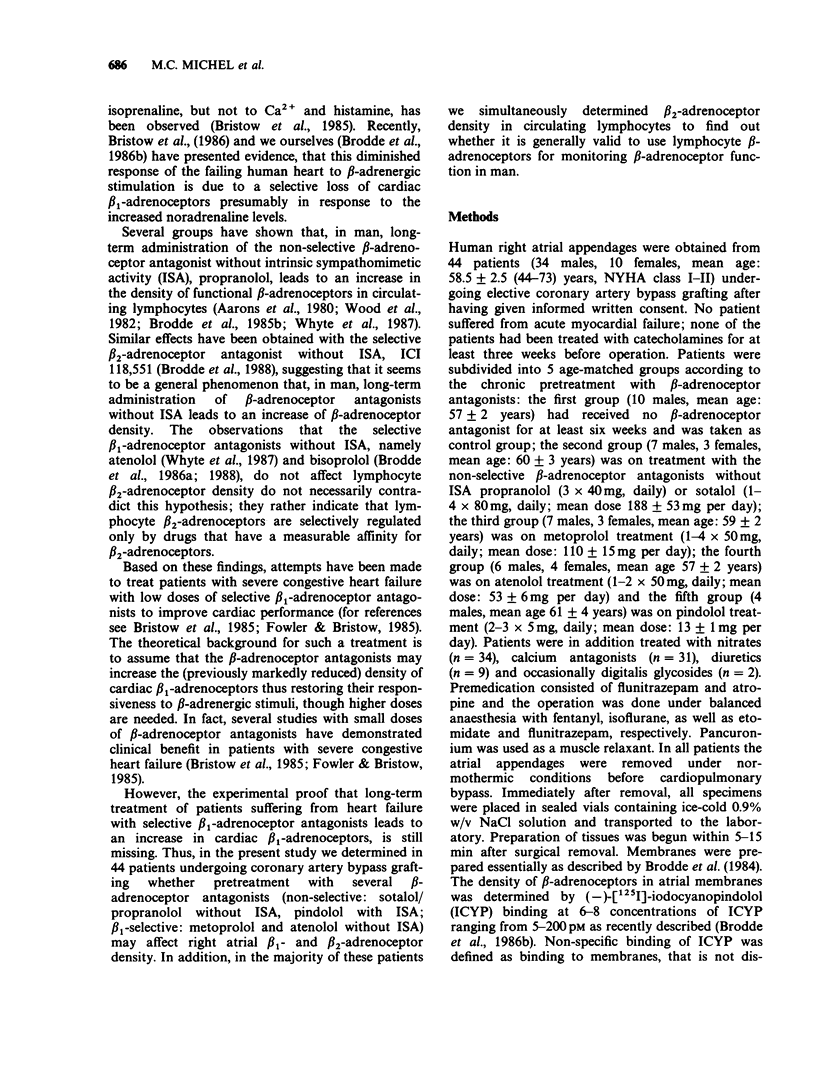
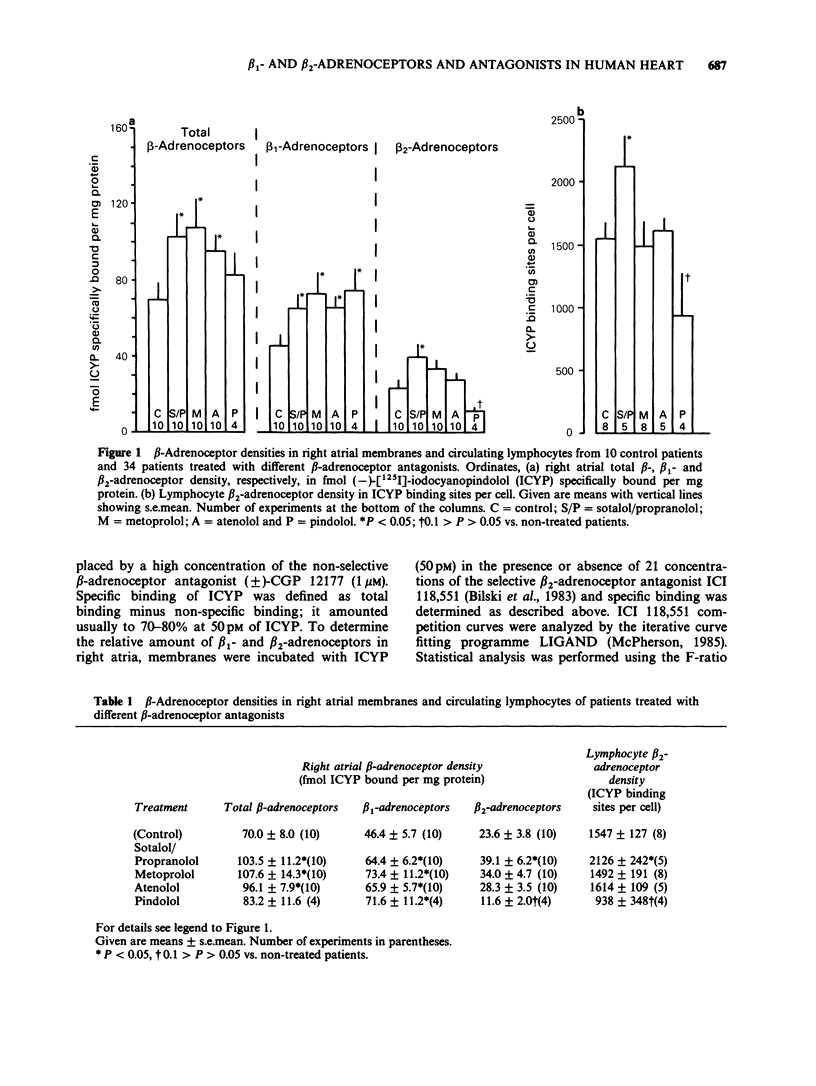
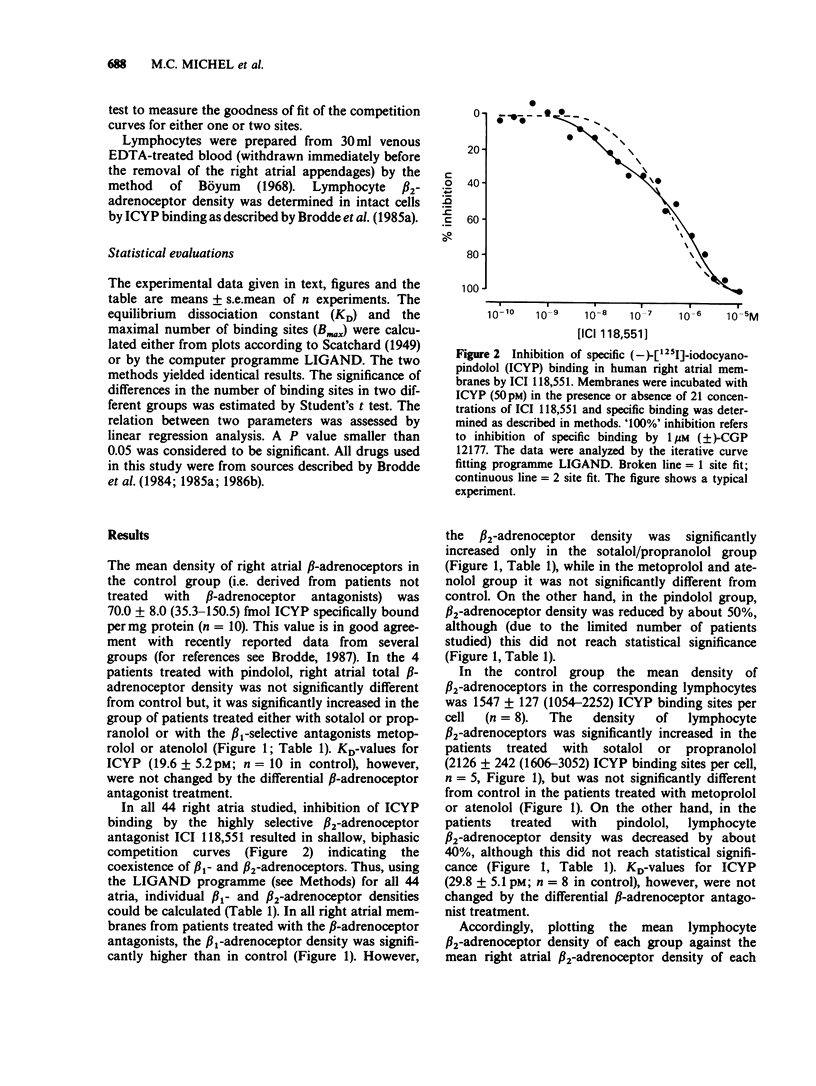
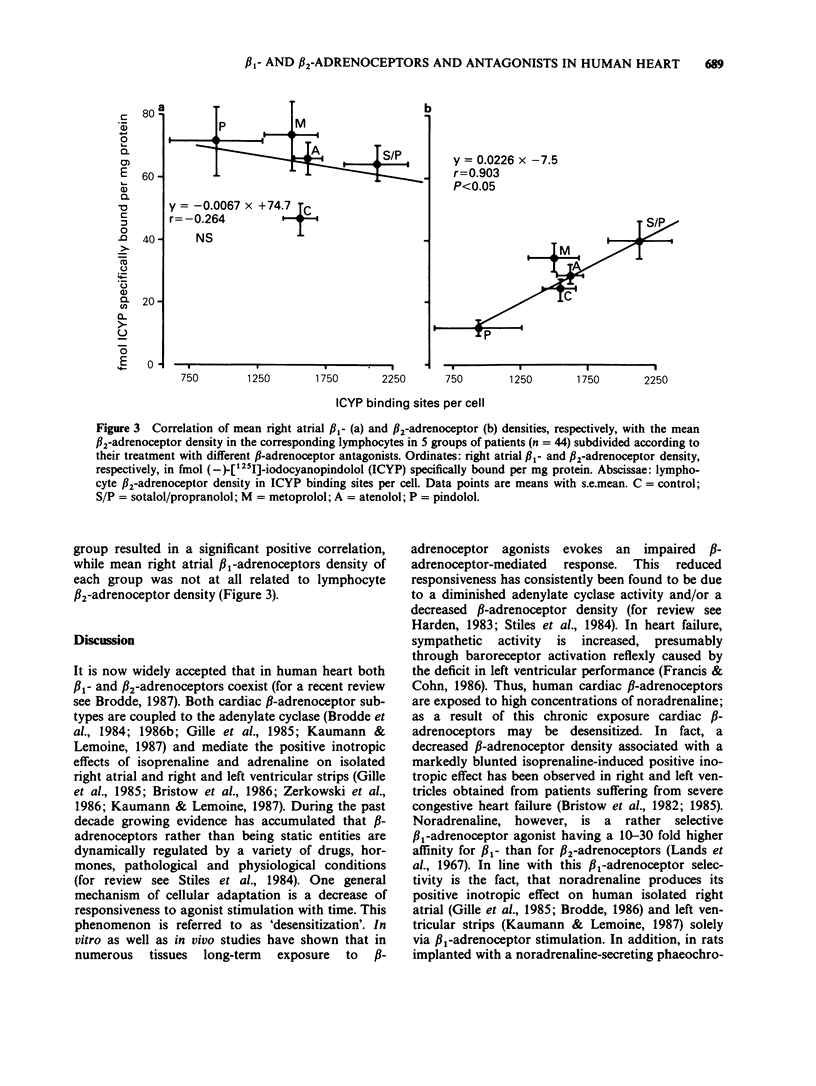
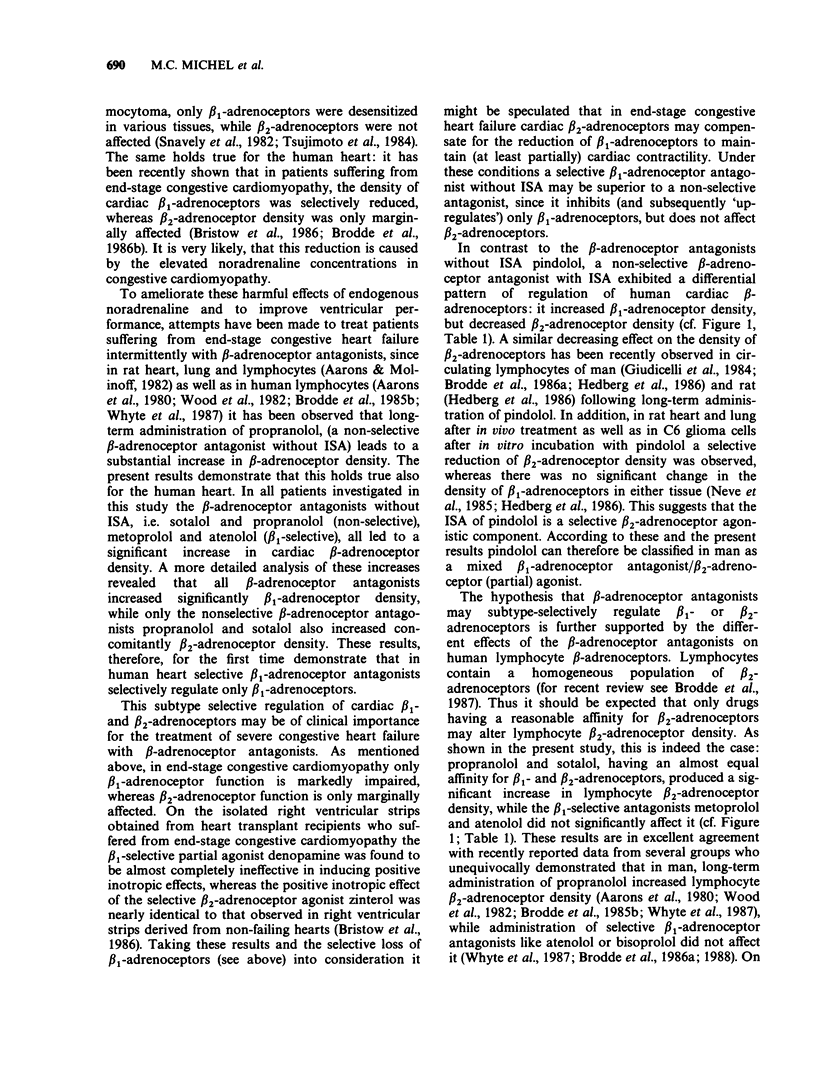
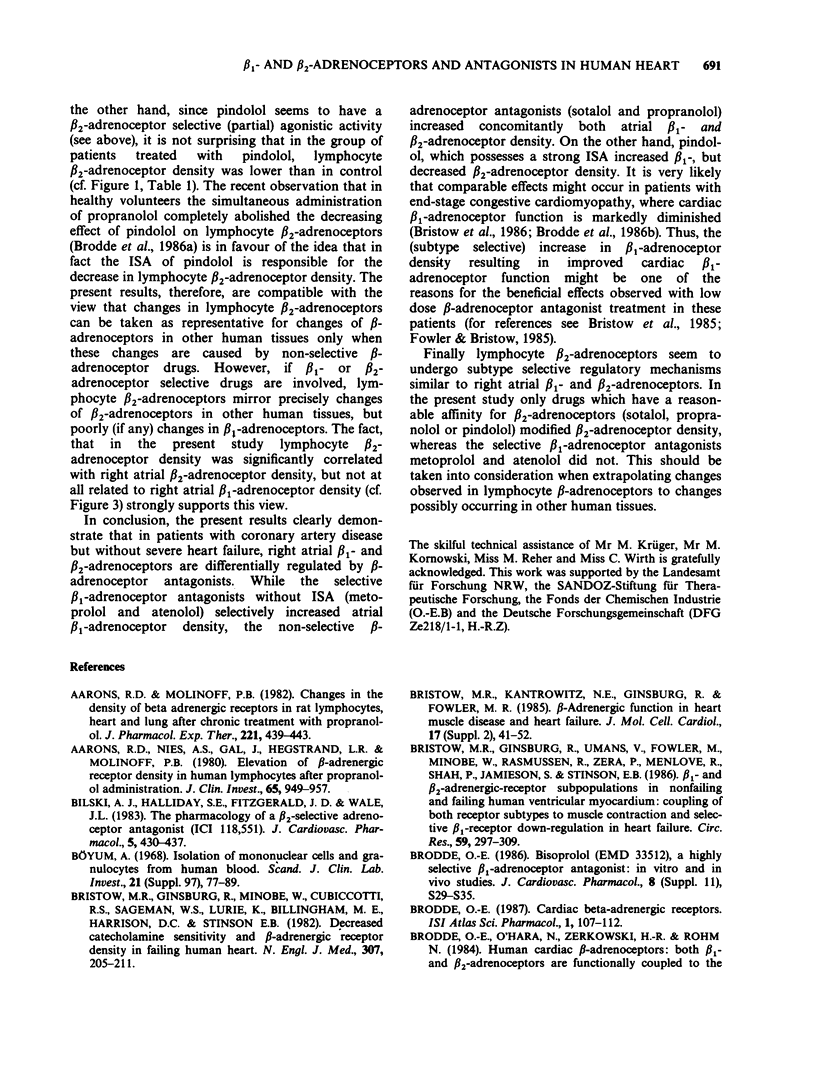
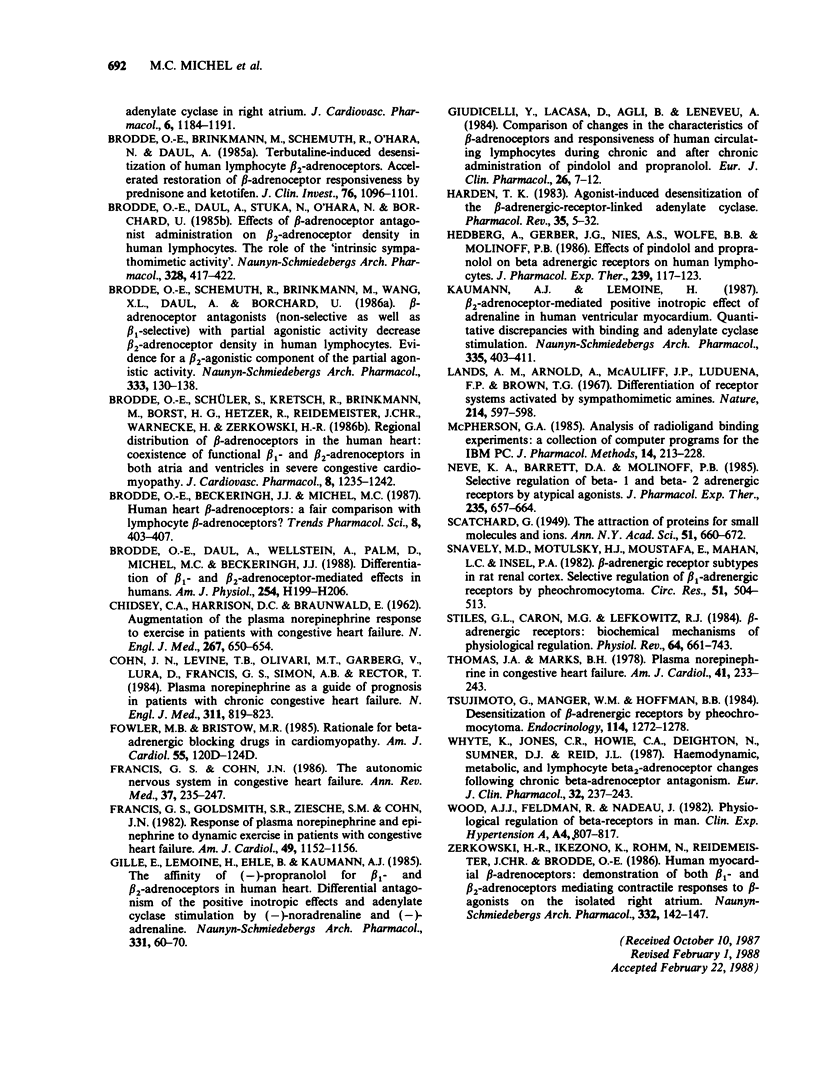
Selected References
These references are in PubMed. This may not be the complete list of references from this article.
- Aarons R. D., Molinoff P. B. Changes in the density of beta adrenergic receptors in rat lymphocytes, heart and lung after chronic treatment with propranolol. J Pharmacol Exp Ther. 1982 May;221(2):439–443. [PubMed] [Google Scholar]
- Aarons R. D., Nies A. S., Gal J., Hegstrand L. R., Molinoff P. B. Elevation of beta-adrenergic receptor density in human lymphocytes after propranolol administration. J Clin Invest. 1980 May;65(5):949–957. doi: 10.1172/JCI109781. [DOI] [PMC free article] [PubMed] [Google Scholar]
- Bilski A. J., Halliday S. E., Fitzgerald J. D., Wale J. L. The pharmacology of a beta 2-selective adrenoceptor antagonist (ICI 118,551). J Cardiovasc Pharmacol. 1983 May-Jun;5(3):430–437. doi: 10.1097/00005344-198305000-00013. [DOI] [PubMed] [Google Scholar]
- Bristow M. R., Ginsburg R., Minobe W., Cubicciotti R. S., Sageman W. S., Lurie K., Billingham M. E., Harrison D. C., Stinson E. B. Decreased catecholamine sensitivity and beta-adrenergic-receptor density in failing human hearts. N Engl J Med. 1982 Jul 22;307(4):205–211. doi: 10.1056/NEJM198207223070401. [DOI] [PubMed] [Google Scholar]
- Bristow M. R., Ginsburg R., Umans V., Fowler M., Minobe W., Rasmussen R., Zera P., Menlove R., Shah P., Jamieson S. Beta 1- and beta 2-adrenergic-receptor subpopulations in nonfailing and failing human ventricular myocardium: coupling of both receptor subtypes to muscle contraction and selective beta 1-receptor down-regulation in heart failure. Circ Res. 1986 Sep;59(3):297–309. doi: 10.1161/01.res.59.3.297. [DOI] [PubMed] [Google Scholar]
- Bristow M. R., Kantrowitz N. E., Ginsburg R., Fowler M. B. Beta-adrenergic function in heart muscle disease and heart failure. J Mol Cell Cardiol. 1985 Jul;17 (Suppl 2):41–52. doi: 10.1016/0022-2828(85)90007-0. [DOI] [PubMed] [Google Scholar]
- Brodde O. E. Bisoprolol (EMD 33512), a highly selective beta 1-adrenoceptor antagonist: in vitro and in vivo studies. J Cardiovasc Pharmacol. 1986;8 (Suppl 11):S29–S35. doi: 10.1097/00005344-198511001-00005. [DOI] [PubMed] [Google Scholar]
- Brodde O. E., Brinkmann M., Schemuth R., O'Hara N., Daul A. Terbutaline-induced desensitization of human lymphocyte beta 2-adrenoceptors. Accelerated restoration of beta-adrenoceptor responsiveness by prednisone and ketotifen. J Clin Invest. 1985 Sep;76(3):1096–1101. doi: 10.1172/JCI112063. [DOI] [PMC free article] [PubMed] [Google Scholar]
- Brodde O. E., Daul A., Stuka N., O'Hara N., Borchard U. Effects of beta-adrenoceptor antagonist administration on beta 2-adrenoceptor density in human lymphocytes. The role of the "intrinsic sympathomimetic activity". Naunyn Schmiedebergs Arch Pharmacol. 1985 Feb;328(4):417–422. doi: 10.1007/BF00692910. [DOI] [PubMed] [Google Scholar]
- Brodde O. E., Daul A., Wellstein A., Palm D., Michel M. C., Beckeringh J. J. Differentiation of beta 1- and beta 2-adrenoceptor-mediated effects in humans. Am J Physiol. 1988 Feb;254(2 Pt 2):H199–H206. doi: 10.1152/ajpheart.1988.254.2.H199. [DOI] [PubMed] [Google Scholar]
- Brodde O. E., Schemuth R., Brinkmann M., Wang X. L., Daul A., Borchard U. Beta-adrenoceptor antagonists (non-selective as well as beta 1-selective) with partial agonistic activity decrease beta 2-adrenoceptor density in human lymphocytes. Evidence for a beta 2-agonistic component of the partial agonistic activity. Naunyn Schmiedebergs Arch Pharmacol. 1986 Jun;333(2):130–138. doi: 10.1007/BF00506515. [DOI] [PubMed] [Google Scholar]
- Brodde O. E., Schüler S., Kretsch R., Brinkmann M., Borst H. G., Hetzer R., Reidemeister J. C., Warnecke H., Zerkowski H. R. Regional distribution of beta-adrenoceptors in the human heart: coexistence of functional beta 1- and beta 2-adrenoceptors in both atria and ventricles in severe congestive cardiomyopathy. J Cardiovasc Pharmacol. 1986 Nov-Dec;8(6):1235–1242. doi: 10.1097/00005344-198611000-00021. [DOI] [PubMed] [Google Scholar]
- Böyum A. Isolation of mononuclear cells and granulocytes from human blood. Isolation of monuclear cells by one centrifugation, and of granulocytes by combining centrifugation and sedimentation at 1 g. Scand J Clin Lab Invest Suppl. 1968;97:77–89. [PubMed] [Google Scholar]
- CHIDSEY C. A., HARRISON D. C., BRAUNWALD E. Augmentation of the plasma nor-epinephrine response to exercise in patients with congestive heart failure. N Engl J Med. 1962 Sep 27;267:650–654. doi: 10.1056/NEJM196209272671305. [DOI] [PubMed] [Google Scholar]
- Cohn J. N., Levine T. B., Olivari M. T., Garberg V., Lura D., Francis G. S., Simon A. B., Rector T. Plasma norepinephrine as a guide to prognosis in patients with chronic congestive heart failure. N Engl J Med. 1984 Sep 27;311(13):819–823. doi: 10.1056/NEJM198409273111303. [DOI] [PubMed] [Google Scholar]
- Fowler M. B., Bristow M. R. Rationale for beta-adrenergic blocking drugs in cardiomyopathy. Am J Cardiol. 1985 Apr 26;55(10):120D–124D. doi: 10.1016/0002-9149(85)91066-5. [DOI] [PubMed] [Google Scholar]
- Francis G. S., Cohn J. N. The autonomic nervous system in congestive heart failure. Annu Rev Med. 1986;37:235–247. doi: 10.1146/annurev.me.37.020186.001315. [DOI] [PubMed] [Google Scholar]
- Francis G. S., Goldsmith S. R., Ziesche S. M., Cohn J. N. Response of plasma norepinephrine and epinephrine to dynamic exercise in patients with congestive heart failure. Am J Cardiol. 1982 Apr 1;49(5):1152–1156. doi: 10.1016/0002-9149(82)90039-x. [DOI] [PubMed] [Google Scholar]
- Gille E., Lemoine H., Ehle B., Kaumann A. J. The affinity of (-)-propranolol for beta 1- and beta 2-adrenoceptors of human heart. Differential antagonism of the positive inotropic effects and adenylate cyclase stimulation by (-)-noradrenaline and (-)-adrenaline. Naunyn Schmiedebergs Arch Pharmacol. 1985 Oct;331(1):60–70. doi: 10.1007/BF00498852. [DOI] [PubMed] [Google Scholar]
- Giudicelli Y., Lacasa D., Agli B., Leneveu A. Comparison of changes in the characteristics of beta-adrenoceptors and responsiveness of human circulating lymphocytes during and after chronic administration of pindolol and propranolol. Eur J Clin Pharmacol. 1984;26(1):7–12. doi: 10.1007/BF00546700. [DOI] [PubMed] [Google Scholar]
- Harden T. K. Agonist-induced desensitization of the beta-adrenergic receptor-linked adenylate cyclase. Pharmacol Rev. 1983 Mar;35(1):5–32. [PubMed] [Google Scholar]
- Hedberg A., Gerber J. G., Nies A. S., Wolfe B. B., Molinoff P. B. Effects of pindolol and propranolol on beta adrenergic receptors on human lymphocytes. J Pharmacol Exp Ther. 1986 Oct;239(1):117–123. [PubMed] [Google Scholar]
- Kaumann A. J., Lemoine H. Beta 2-adrenoceptor-mediated positive inotropic effect of adrenaline in human ventricular myocardium. Quantitative discrepancies with binding and adenylate cyclase stimulation. Naunyn Schmiedebergs Arch Pharmacol. 1987 Apr;335(4):403–411. doi: 10.1007/BF00165555. [DOI] [PubMed] [Google Scholar]
- Lands A. M., Arnold A., McAuliff J. P., Luduena F. P., Brown T. G., Jr Differentiation of receptor systems activated by sympathomimetic amines. Nature. 1967 May 6;214(5088):597–598. doi: 10.1038/214597a0. [DOI] [PubMed] [Google Scholar]
- McPherson G. A. Analysis of radioligand binding experiments. A collection of computer programs for the IBM PC. J Pharmacol Methods. 1985 Nov;14(3):213–228. doi: 10.1016/0160-5402(85)90034-8. [DOI] [PubMed] [Google Scholar]
- Neve K. A., Barrett D. A., Molinoff P. B. Selective regulation of beta-1 and beta-2 adrenergic receptors by atypical agonists. J Pharmacol Exp Ther. 1985 Dec;235(3):657–664. [PubMed] [Google Scholar]
- Snavely M. D., Motulsky H. J., Moustafa E., Mahan L. C., Insel P. A. beta-Adrenergic receptor subtypes in the rat renal cortex. Selective regulation of beta 1-adrenergic receptors by pheochromocytoma. Circ Res. 1982 Oct;51(4):504–513. doi: 10.1161/01.res.51.4.504. [DOI] [PubMed] [Google Scholar]
- Stiles G. L., Caron M. G., Lefkowitz R. J. Beta-adrenergic receptors: biochemical mechanisms of physiological regulation. Physiol Rev. 1984 Apr;64(2):661–743. doi: 10.1152/physrev.1984.64.2.661. [DOI] [PubMed] [Google Scholar]
- Thomas J. A., Marks B. H. Plasma norepinephrine in congestive heart failure. Am J Cardiol. 1978 Feb;41(2):233–243. doi: 10.1016/0002-9149(78)90162-5. [DOI] [PubMed] [Google Scholar]
- Tsujimoto G., Manger W. M., Hoffman B. B. Desensitization of beta-adrenergic receptors by pheochromocytoma. Endocrinology. 1984 Apr;114(4):1272–1278. doi: 10.1210/endo-114-4-1272. [DOI] [PubMed] [Google Scholar]
- Whyte K., Jones C. R., Howie C. A., Deighton N., Sumner D. J., Reid J. L. Haemodynamic, metabolic, and lymphocyte beta 2-adrenoceptor changes following chronic beta-adrenoceptor antagonism. Eur J Clin Pharmacol. 1987;32(3):237–243. doi: 10.1007/BF00607569. [DOI] [PubMed] [Google Scholar]
- Wood A. J., Feldman R., Nadeau J. Physiological regulation of beta-receptors in man. Clin Exp Hypertens A. 1982;4(4-5):807–817. doi: 10.3109/10641968209061614. [DOI] [PubMed] [Google Scholar]
- Zerkowski H. R., Ikezono K., Rohm N., Reidemeister J. C., Brodde O. E. Human myocardial beta-adrenoceptors: demonstration of both beta 1- and beta 2-adrenoceptors mediating contractile responses to beta-agonists on the isolated right atrium. Naunyn Schmiedebergs Arch Pharmacol. 1986 Feb;332(2):142–147. doi: 10.1007/BF00511404. [DOI] [PubMed] [Google Scholar]


